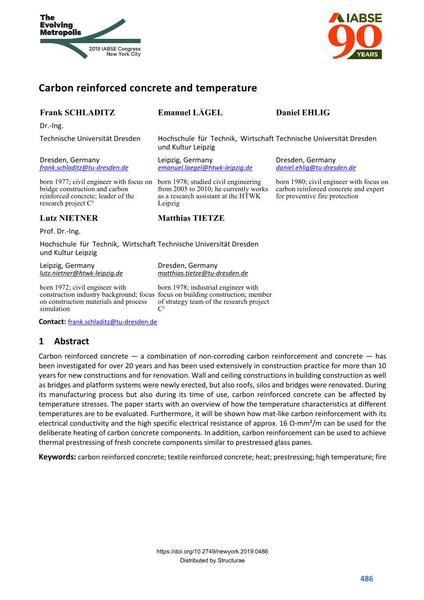Carbon reinforced concrete and temperature

|
|
|||||||||||
Bibliografische Angaben
| Autor(en): |
Frank Schladitz
(Technische Universität Dresden)
Emanuel Lägel (Hochschule für Technik, Wirtschaft und Kultur Leipzig) Daniel Ehlig (Technische Universität Dresden) |
||||
|---|---|---|---|---|---|
| Medium: | Tagungsbeitrag | ||||
| Sprache(n): | Englisch | ||||
| Tagung: | IABSE Congress: The Evolving Metropolis, New York, NY, USA, 4-6 September 2019 | ||||
| Veröffentlicht in: | The Evolving Metropolis | ||||
|
|||||
| Seite(n): | 486-492 | ||||
| Anzahl der Seiten (im PDF): | 7 | ||||
| DOI: | 10.2749/newyork.2019.0486 | ||||
| Abstrakt: |
Carbon reinforced concrete — a combination of non-corroding carbon reinforcement and concrete — has been investigated for over 20 years and has been used extensively in construction practice for more than 10 years for new constructions and for renovation. Wall and ceiling constructions in building construction as well as bridges and platform systems were newly erected, but also roofs, silos and bridges were renovated. During its manufacturing process but also during its time of use, carbon reinforced concrete can be affected by temperature stresses. The paper starts with an overview of how the temperature characteristics at different temperatures are to be evaluated. Furthermore, it will be shown how mat-like carbon reinforcement with its electrical conductivity and the high specific electrical resistance of approx. 16 Ω-mm²/m can be used for the deliberate heating of carbon concrete components. In addition, carbon reinforcement can be used to achieve thermal prestressing of fresh concrete components similar to prestressed glass panes. |
||||
| Stichwörter: |
Vorspannung Brand TRC
|
||||
